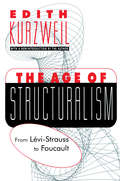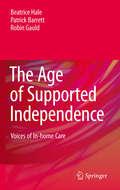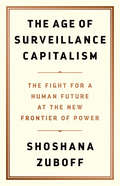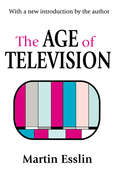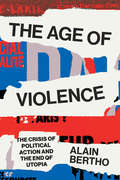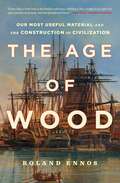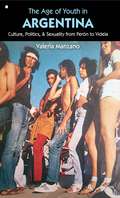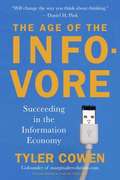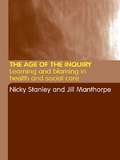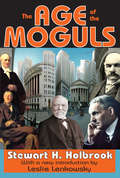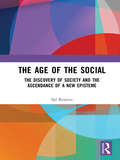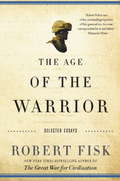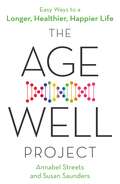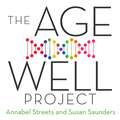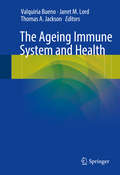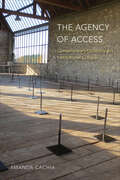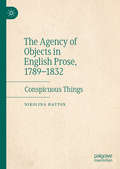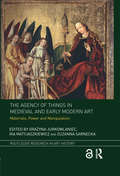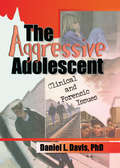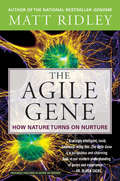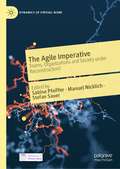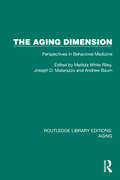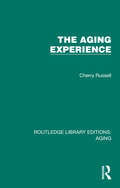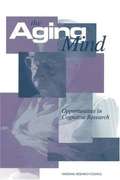- Table View
- List View
The Age of Structuralism: From Levi-Strauss to Foucault
by Edith KurzweilStructuralism began in linguistics and was enlarged by Claude Levi-Strauss into a new way of thinking that views our world as consisting of relationships between structures we create rather than of objective realities. The Age of Structuralism examines the work of seven writers who either expanded upon or reacted against Levi-Strauss.In a panoramic overview of the origins of deconstructionism and its critics, Edith Kurzweil offers a lucid and penetrating portrait of the movement that dominated French intellectual life for much of the postwar era, and which continues to influence the French intellectual milieu. She explains Levi-Strauss's strikingly original contributions, then proceeds to illuminate the ideas of crusaders and critics. The key figures dealt with include: Louis Althusser, who reinterpreted Marxism through a rereading of Marx's texts with the help of structuralist techniques; Henri Lefebvre, who remained faithful to Marx's humanism and was one of the earliest and most vehement critics of structuralism; Paul Ricoeur, whose phenomenology sought to reconcile ethical theory and intellectual pursuits; Alain Touraine, a socialist whose sociology of political action led him to dismiss structuralist concerns; Jacques Lacan, who criticized ego-oriented psychoanalytic theory and practice, and whose own work emphasized linguistic structures in psychoanalysis; Roland Barthes, whose literary criticism, in its determination to reject all false notions and systems, led to a highly idiosyncratic approach that drew upon all systems; and finally, Michel Foucault, whose social histories of deviance, medicine, psychology, grammar, language, sexuality criminology, have reexamined every facet of social theory.Placing these major figures in the context of political, historical, and psychoanalytic currents of the time, The Age of Structuralism is a commanding and far-reaching study of a decisive epoch in intellectual history. Kurzweil's new opening essay explains how these towering figures prefigured current emphasis on semiotics, post-structuralism, deconstruction, and post-postmodernism. Kurt H. Wolff called it "lucid, splendid and unobtrusive" when the book first appeared. It remains a central work in the appreciation of the French giants upon whose shoulders the new crop of thinkers expect to stand.
The Age of Supported Independence
by Patrick Barrett Beatrice Hale Robin GauldThis book investigates the experiences of older people who remain at home with care. It examines the transition points for the important life changes faced by family members who take on a greater care-giving role. The book draws on demographic analyses and qualitative fieldwork to explore the shift from independence to increasing dependence, and suggests that this transition constitutes movement into a new stage of life, that of an Age of Supported Independence. Applying the anthropological concept of rites of passage in their analysis, the authors focus on the changes in everyday living within the spatial environment of the home, the temporal organization of daily life, and the reshaping of relationships. They suggest that many older people - as well as the family members who become carers - remain in a state of 'liminality': unable to make sense of their new situation and experience and, despite assumptions that ageing-in-place sustains social connectedness, excluded from their communities.
The Age of Surveillance Capitalism: The Fight for a Human Future at the New Frontier of Power
by Shoshana ZuboffThe challenges to humanity posed by the digital future, the first detailed examination of the unprecedented form of power called "surveillance capitalism," and the quest by powerful corporations to predict and control our behavior. <P><P>Shoshana Zuboff's interdisciplinary breadth and depth enable her to come to grips with the social, political, business, and technological meaning of the changes taking place in our time. We are at a critical juncture in the confrontation between the vast power of giant high-tech companies and government, the hidden economic logic of surveillance capitalism, and the propaganda of machine supremacy that threaten to shape and control human life. <P><P>Will the brazen new methods of social engineering and behavior modification threaten individual autonomy and democratic rights and introduce extreme new forms of social inequality? Or will the promise of the digital age be one of individual empowerment and democratization? <P><P>The Age of Surveillance Capitalism is neither a hand-wringing narrative of danger and decline nor a digital fairy tale. Rather, it offers a deeply reasoned and evocative examination of the contests over the next chapter of capitalism that will decide the meaning of information civilization in the twenty-first century. The stark issue at hand is whether we will be the masters of information and machines or its slaves.
The Age of Television
by Martin EsslinHaving spent most of his career working with the British Broadcasting Corporation (BBC), Martin Esslin appraises American TV with the eyes of both a detached outsider and a concerned insider. "American popular culture," writes Esslin, "has become the popular culture of the world at large. American television is thus more than a purely social phenomenon. It fascinates and in some instances frightens the whole world." The Age of Television discusses television as an essentially dramatic form of communication, pointing to the strengths and weaknesses that spring from its character. It explores its impact on generations destined to grow up under its influence, with such questions as how TV turns reality into fiction, and fiction into reality. Esslin considers the long-term effects of television on our abilities to reason, to read, to create. He asks if current programming on American television constitutes what we want and deserve, and asks what we would change, if we could. These are but a handful of the questions Esslin probes in this penetrating analysis of contemporary television and its impact on our lives. In his new introduction, Esslin discusses changes in the media over the last two decades. He explores the increasing number of television stations available, the rise of "boutique" channels concentrating on news, sports, or film, and the relationship between television and other forms of electronic media such as video games and the Internet. Finally, he considers the effect of these developments on our ability to concentrate, our sensitivity to violence, and even our artistic taste. Most compelling of all is his final question: Can the Age of Television, with all its dangers, yet become a golden age of cultural growth? Martin Esslin is professor emeritus of drama at Stanford University. His numerous critical works include: Brecht-The Man and his Work, The Theatre of the Absurd, An Anatomy of Drama, and Artaud. He cur
The Age of Violence: The Crisis of Political Action and the End of Utopia
by Alain BerthoExploring the fury of the young in a world or crisis that seems to offer no alternatives"Only martyrs know neither pity nor fear. Believe me, the day when the martyrs are victorious will be the day of universal conflagration". Jacques Lacan made this gloomy prophesy back in 1959: but doesn't it also apply to our own time? Faced with a rise in attacks around the world, can we really just blame the 'radicalization of' Islam'? What hope is there for the alienated youth, as the wars that have ravaged the Middle East spill out across the globe?For Alain Bertho, the mounting chaos we see today is above all driven by the weakening of states' legitimacy under the pressure of globalization. Add to this the hypocrisy of the elites who beat the drum of 'security measures', even as they sow the seeds of violence around the world. This disorder is the swamp of despair which can only produce fresh atrocities.Today's youth are the lost children of neoliberal globalization, the inheritors of the political and human chaos it produces. When they find it easier to imagine the end of the world than the end of capitalism, their revolt tends to take the paths of martyrdom and despair. The closing of the revolutionary hypothesis allows only fury. The answer, Bertho argues, is a new radicalism, able to inspire a collective hope in the future.
The Age of Wood: Our Most Useful Material and the Construction of Civilization
by Roland EnnosA &“smart and surprising&” (Booklist) &“expansive history&” (Publishers Weekly) detailing the role that wood and trees have played in our global ecosystem—including human evolution and the rise and fall of empires—in the bestselling tradition of Yuval Harari&’s Sapiens and Mark Kurlansky&’s Salt.As the dominant species on Earth, humans have made astonishing progress since our ancestors came down from the trees. But how did the descendants of small primates manage to walk upright, become top predators, and populate the world? How were humans able to develop civilizations and produce a globalized economy? Now, in The Age of Wood, Roland Ennos shows for the first time that the key to our success has been our relationship with wood. &“A lively history of biology, mechanics, and culture that stretches back 60 million years&” (Nature) The Age of Wood reinterprets human history and shows how our ability to exploit wood&’s unique properties has profoundly shaped our bodies and minds, societies, and lives. Ennos takes us on a sweeping journey from Southeast Asia and West Africa where great apes swing among the trees, build nests, and fashion tools; to East Africa where hunter gatherers collected their food; to the structural design of wooden temples in China and Japan; and to Northern England, where archaeologists trace how coal enabled humans to build an industrial world. Addressing the effects of industrialization—including the use of fossil fuels and other energy-intensive materials to replace timber—The Age of Wood not only shows the essential role that trees play in the history and evolution of human existence, but also argues that for the benefit of our planet we must return to more traditional ways of growing, using, and understanding trees. A brilliant blend of recent research and existing scientific knowledge, this is an &“excellent, thorough history in an age of our increasingly fraught relationships with natural resources&” (Kirkus Reviews, starred review).
The Age of Youth in Argentina
by Valeria ManzanoThis social and cultural history of Argentina's "long sixties" argues that the nation's younger generation was at the epicenter of a public struggle over democracy, authoritarianism, and revolution from the mid-twentieth century through the ruthless military dictatorship that seized power in 1976. Valeria Manzano demonstrates how, during this period, large numbers of youths built on their history of earlier activism and pushed forward closely linked agendas of sociocultural modernization and political radicalization.Focusing also on the views of adults who assessed, and sometimes profited from, youth culture, Manzano analyzes countercultural formations--including rock music, sexuality, student life, and communal living experiences--and situates them in an international context. She details how, while Argentines of all ages yearned for newness and change, it was young people who championed the transformation of deep-seated traditions of social, cultural, and political life. The significance of youth was not lost on the leaders of the rising junta: people aged sixteen to thirty accounted for 70 percent of the estimated 20,000 Argentines who were "disappeared" during the regime.
The Age of the Infovore: Succeeding in the Information Economy
by Tyler Cowen"Will change the way you think about thinking. " -Daniel H. Pink, author of A Whole New Mind Renowned behavioral economist and commentator Tyler Cowen shows that our supernetworked world is changing the way we think-and empowering us to thrive in any economic climate. Whether it is micro-blogging on Twitter or buying single songs at iTunes, we can now customize our lives to shape our own specific needs. In other words, we can create our own economy-and live smarter, happier, fuller lives. At a time when apocalyptic thinking has become all too common, Cowen offers a much- needed information age manifesto that will resonate with readers of Dan Ariely's Predictably Irrational, Steven Johnson's Everything Bad is Good for You, and everyone hungry to understand our potential to withstand, and even thrive, in any economic climate. .
The Age of the Inquiry: Learning and Blaming in Health and Social Care
by Nicky Stanley Jill ManthorpeThe plethora of inquiry reports published in the fields of health and welfare in the 1990s covered the full range of user groups, individuals and institutions. What similarities or differences were there between these inquiries? How effective were they in bringing about change? Whose interest did they best serve?These are some of the questions The Age of the Inquiry explores in detail, bringing together distinguished contributors with personal experience of chairing or providing evidence to inquiries to consider: the participant's view of inquiriesthe purpose of inquiriesthe impact of inquiries on health and social policyinquiries into: child abuse and death; homicides by mental health service users; the abuse of adults with learning disabilities; the abuse of older people. Wide-ranging in scope, The Age of the Inquiry focuses on service and policy development. It provides an invaluable text for students, teachers and professionals from a wide range of disciplines and professional groups.
The Age of the Moguls
by Stewart HolbrookVanderbilt, Carnegie, Rockefeller, Ford, Drew, Fisk, Harriman, Du Pont, Morgan, Mellon, Insull, Gould, Frick, Schwab, Swift, Guggenheim, Hearst- these are only a few of the foundation giants that have changed the face of America. They gave living reality to that great golden legend-The American Dream. Most were self-made in the Horatio Alger tradition. Those whose beginnings were blessed with wealth parlayed their inheritances many times through the same methods as their rags-to-riches compatriots: shrewdness, ruthlessness, determination, or a combination of all three.The Age of the Moguls is not overly concerned with the comparative business ethics of these men of money. The best of them made "deals," purchased immunity, and did other things which in 1860, 1880, or even 1900, were considered no more than "smart" by their fellow Americans, but which today would give pause to the most conscientiously dishonest promoter. Holbrook does not pass judgments on matters that have baffled moralists, economists, and historians. He is less concerned with how these men achieved their fortune as much as how they disbursed the funds.Stewart Holbrook has written a brilliant and wholly captivating study of the days when America's great fortunes were built; when futures were unlimited; when tycoons trampled across the land. Few writers today could range backwards and forwards in American history through the last century and a half, and could take their readers to a dozen different sections of the country, or combine the lives of over fifty famous men in such a way as to produce a continuous and exciting narrative of sponsored growth. Leslie Lenkowsky's new introduction adds dimension to this classic study.
The Age of the Social: The Discovery of Society and The Ascendance of a New Episteme
by Sal RestivoThe concept of society sui generis – society as a level of reality which could be studied scientifically – crystallized in the middle of the nineteenth century in Europe, with the work of Durkheim, Marx and Weber and today, more than at any other period in history, the idea of the social has gained a foothold in philosophy, biology, and neuroscience. However, this idea has emerged into prominence not through the historical or contemporary efforts of sociologists, but mainly through the efforts of biologists and neuroscientists. This book seeks to re-establish the credentials of sociology as the science of society. While acknowledging the amalgamation of traditional disciplines into interdisciplinary and multidisciplinary networks of research and theory, and championing interdisciplinarity in recognising the capacity of converging perspectives to yield more interesting general theories of social life, the author defends disciplinarity in maintaining sociology’s achievements as a discipline. With chapters on the sociological world view, imagining society, the self, love, education, mathematics and religion, The Age of the Social re-states the importance of sociology as the source of robust ideas about the social in an age in which this notion has grown in importance. As such, it will appeal to scholars across the social sciences, with interests in method and philosophy in the social disciplines.
The Age of the Warrior: Selected Essays by Robert Fisk
by Robert FiskRobert Fisk has amassed a massive and devoted global readership with his eloquent and far-ranging articles on international politics. Now, for the first time, his brave and incisive essays have been collected in a single volume that ranges in scope from the recent war in Lebanon to the rise of Hamas; from the invasion of Kuwait to the looting of Baghdad; from America's imperial ambitions to the inescapable influence of the Treaty of Versailles. Taken together, these articles form an unparalleled account of our war-torn recent history.
The Age-Well Project: Easy Ways to a Longer, Healthier, Happier Life
by Susan Saunders Annabel Streets'The essential mid-life mum makeover. From fitness to sleep and even your social life, a brilliant new book by two 50-something mothers reveals how to protect your health and happiness' Daily Mail'Educational and informative' Woman's WayAn essential handbook for making the second half of your life happy, healthy and disease-free.Diseases of older age take root decades before symptoms appear. For a longer, happier life, we need to plan ahead - but what exactly should we do?For five years, Annabel Streets and Susan Saunders immersed themselves in the latest science of longevity, radically overhauling their lives and documenting their findings on their popular blog.After reading hundreds of studies and talking to numerous experts, Annabel and Susan have compiled almost 100 short cuts to health in mid and later life, including: how, when and what to eat; the supplements worth taking; when, where and how to exercise; the most useful medical tests; how to avoid health-threatening chemicals; the best methods for keeping the brain sharp; and how to sleep better.
The Age-Well Project: Easy Ways to a Longer, Healthier, Happier Life
by Susan Saunders Annabel Streets'The essential mid-life mum makeover. From fitness to sleep and even your social life, a brilliant new book by two 50-something mothers reveals how to protect your health and happiness' Daily Mail'Educational and informative' Woman's WayDiseases of older age take root decades before symptoms appear. For a longer, happier life, we need to plan ahead - but what exactly should we do?For five years, Annabel Streets and Susan Saunders immersed themselves in the latest science of longevity, radically overhauling their lives and documenting their findings on their popular blog.After reading hundreds of studies and talking to numerous experts, Annabel and Susan have compiled almost 100 short cuts to health in mid and later life, including: how, when and what to eat; the supplements worth taking; when, where and how to exercise; the most useful medical tests; how to avoid health-threatening chemicals; the best methods for keeping the brain sharp; and how to sleep better.The Age-Well Project is an essential handbook for making the second half of your life happy, healthy and disease-free.
The Ageing Immune System and Health
by Janet M. Lord Valquiria Bueno Thomas A. JacksonThe present book intends to provide an update on immunosenescence and how deficiencies in the immune system contribute to a higher susceptibility to infections, decline in organ function, reduced vaccination responses, age-related disease and the ageing process itself, negatively affecting longevity. Our focus is on the main changes in immune system cells and their products occurring during the ageing process and the possible consequences for health and disease. This includes: discussion of the modulatory and/or suppressive mechanisms associated with the alterations in T regulatory cells, B regulatory cells and Myeloid Derived Suppressor cells; changes in the immune system observed in chronic neurodegenerative diseases, cancer, lung disease and frailty will also be discussed. Most importantly we provide recent literature information about possible interventions (focusing on physical activity) that could alleviate the negative effects of immunosenescence. The Ageing Immune System and Health is a comprehensive guide on the field intended to all physicians, researchers, professors and students interested on relationship between immune system, ageing and health.
The Agency of Access: Contemporary Disability Art & Institutional Critique
by Amanda CachiaThe Agency of Access examines how access can be employed as a methodology for curating art exhibitions using a multi-sensorial approach. Crip curator and art historian Amanda Cachia illustrates how bodies take in information and process stimuli, making the inequities in museums and galleries more transparent. She also argues that, as contemporary disabled artists move away from representations of disability, they create an art of access, or access aesthetics, through works that center translation, sensory expansion, touch, and movement for audiences and offer an experience of “being with” disability. Showcasing artwork by contemporary disabled artists Corban Walker, Christine Sun Kim, and Carmen Papalia, among others, The Agency of Access inscribes contemporary disability art in the broad canon of contemporary art, where the artistic past is regarded differently. Cachia is an outspoken advocate for artists living with sensory disabilities. She understands disabled artists’ experiences in both the world and the gallery. The artists she has curated make bold, astonishing, and compelling statements about interdependency, care, and the ways in which our environment affects disabled, ill, and immunocompromised bodies.
The Agency of Children
by David OswellThe idea of children's agency is central to the growing field of childhood studies. In this book David Oswell argues for new understandings of children's agency. He traces the transformation of children and childhood across the nineteenth, twentieth and early twenty-first centuries and explores the dramatic changes in recent years to children's everyday lives as a consequence of new networked, mobile technologies and new forms of globalisation. The author reviews existing theories of children's agency as well as providing the theoretical tools for thinking of children's agency as spatially, temporally and materially complex. With this in mind, he surveys the main issues in childhood studies, with chapters covering family, schooling, crime, health, consumer culture, work and human rights. This is a comprehensive text intended for students and academic researchers across the humanities and social sciences interested in the study of children and childhood.
The Agency of Objects in English Prose, 1789–1832: Conspicuous Things
by Nikolina HattonThe Agency of Objects in English Prose, 1789–1832: Conspicuous Things engages with new materialist methodologies to examine shifting perceptions of nonhuman agency in English prose at the turn of the nineteenth century. Examining texts as diverse as it-narratives, the juvenile writings and novels of Jane Austen, De Quincey’s autobiographical writings, and silver fork novels, Nikolina Hatton demonstrates how object agency is viewed in this period as constitutive—not just in regard to human subjectivity but also in aesthetic creation. Objects appear in these novels and short prose works as aids, intermediaries, adversaries, and obstructions, as well as both intimately connected to humans and strangely alien. Through close readings, the book traces how object agency, while sometimes perceived as a threat by authors and characters, also continues to be understood as a source of the delightfully unexpected—in everyday life as well as in narrative.
The Agency of Things in Medieval and Early Modern Art: Materials, Power and Manipulation (Routledge Research in Art History)
by Grażyna Jurkowlaniec Ika Matyjaszkiewicz Zuzanna SarneckaThis volume explores the late medieval and early modern periods from the perspective of objects. While the agency of things has been studied in anthropology and archaeology, it is an innovative approach for art historical investigations. Each contributor takes as a point of departure active things: objects that were collected, exchanged, held in hand, carried on a body, assembled, cared for or pawned. Through a series of case studies set in various geographic locations, this volume examines a rich variety of systems throughout Europe and beyond.
The Aggressive Adolescent: Clinical and Forensic Issues
by Daniel L DavisMaximize your effectiveness with troubled kids!The Aggressive Adolescent: Clinical and Forensic Issues provides mental health professionals with a comprehensive text that covers both theoretical and practical applied knowledge of aggressive youth in a specific, problem-focused way. Through case histories and practical treatment interventions, this unique book will give you information to help you provide improved services to adolescents who have experienced neglect, physical abuse, and/or sexual abuse. The Aggressive Adolescent offers you a new model for practical and functional assessment, treatment, planning, and service delivery for aggressive youths. The book also explores legal and forensic issues that frequently accompany these cases to bring you insight into the whole picture surrounding problem adolescents. Compelling and comprehensive, The Aggressive Adolescent shows you how some behaviors once attributed to mental illness are now seen as criminal, and how this view is pushing mentally ill youths into the criminal justice system. This vital guide will help you, as a mental health professional, to bolster your understanding of forensic mental health issues and effectively assist in criminal justice settings.The Aggressive Adolescent will help you become a better, more connected youth care worker. You will learn: to see institutionalized adolescents as whole people rather than focusing on a single characteristic such as violent behavior to understand that these adolescents share common needs, desires, and aspirations with their therapists, and that you can use these commonalities to give you a connection that will facilitate their therapy to see that traditional methods of intervention are often inappropriate or ineffective for aggressive adolescents to address issues of risk assessment, malpractice, and liability, to help ensure fiscal and legal accountability The Aggressive Adolescent presents strategies for dealing with youths who are resistant to entering into treatment so that you can help them deal with their problems. This essential book will assist you in developing and implementing effective systems of care for aggressive adolescents in order to give them the help and support they need.
The Agile Gene: How Nature Turns on Nurture
by Matt RidleyArmed with extraordinary new discoveries about our genes, acclaimed science writer Matt Ridley turns his attention to the nature-versus-nurture debate in a thoughtful book about the roots of human behavior.Ridley recounts the hundred years' war between the partisans of nature and nurture to explain how this paradoxical creature, the human being, can be simultaneously free-willed and motivated by instinct and culture. With the decoding of the human genome, we now know that genes not only predetermine the broad structure of the brain, they also absorb formative experiences, react to social cues, and even run memory. They are consequences as well as causes of the will.
The Agile Imperative: Teams, Organizations and Society under Reconstruction? (Dynamics of Virtual Work)
by Sabine Pfeiffer Stefan Sauer Manuel NicklichIn an ever-changing working environment, customer and workplace demands have brought new challenges to how we organize and manage work. Increasingly, this is addressed by the idea of 'agility.' From its beginning, agile work has claimed to be a radically different approach which allows organisations to react flexibly to changing environmental demands whilst also offering a ‘people' centered approach to management.While the literature often examines agile instruments from a business perspective, this edited collection advances the discussion of the efficacy of agile working, by applying a more critical social science perspective.The chapters scrutinize whether agility is just a discursive imperative, or whether it is in fact a genuine organizational and institutional strategy that is meant to better deal with complexity and volatility. The answers to these questions can vary at different levels, and the editors therefore examine agility at the level of teams, organizations and societies. By assembling different perspectives on the sustainability and virtue of agile instruments, and by bringing together international scholars from a variety of disciplines, the project stimulates a comparative discussion.
The Aging Dimension: Perspectives in Behavioral Medicine (Routledge Library Editions: Aging)
by Andrew Baum Matilda White Riley Joseph D. MatarazzoOriginally published in 1987, this volume, and the working conference that preceded it, broke new ground in addressing the complex topic of aging, health, and behavior. Taking a bio-behavioral approach to a range of topics, contributors to this book advanced their disciplines. This volume as well as searching for important interfaces between behavior and health also added the dynamic aspect of aging. Cells, organ systems, and whole human beings all change as they move through life, linking health in varied and intricate ways to changes in behavior patterns, social structures, and cultural values and norms.
The Aging Experience (Routledge Library Editions: Aging)
by Cherry RussellLocal writing on the subject of old age had tended to a fairly uniform approach, focusing on empirical studies of old age as a social problem using census and survey-type data. Little attention had been paid to theory development. Originally published in 1981, this book provides an in-depth study of how old age was experienced in contemporary Australian society at the time. It was the first major piece of original research on aging to be published in Australia and in several important senses represented a clear departure from the mainstream of Australian gerontology. The Aging Experience links original in-depth data to a broad theoretical framework. Working from the premise that old age is a devalued status it examines the implications of this for the personal experience and interpersonal relations of elderly people. Through detailed case studies of elderly Australians their interaction with family, age peers and welfare services are described. The analysis concentrates less on the overt characteristics of these relationships and their material functions than on their symbolic content and meaning for the participants. Thus, the study moves beyond conventional statistical documentation of the problems of old age to a sharper delineation of aging as a lived experience. It is an approach which offers new perspectives, and challenges many of the assumptions underlying previous research.
The Aging Mind: Opportunities in Cognitive Research
by Committee on Future Directions for Cognitive Research on AgingPossible new breakthroughs in understanding the aging mind that can be used to benefit older people are now emerging from research. This volume identifies the key scientific advances and the opportunities they bring. For example, science has learned that among older adults who do not suffer from Alzheimer’s disease or other dementias, cognitive decline may depend less on loss of brain cells than on changes in the health of neurons and neural networks. Research on the processes that maintain neural health shows promise of revealing new ways to promote cognitive functioning in older people. Research is also showing how cognitive functioning depends on the conjunction of biology and culture. The ways older people adapt to changes in their nervous systems, and perhaps the changes themselves, are shaped by past life experiences, present living situations, changing motives, cultural expectations, and emerging technology, as well as by their physical health status and sensory-motor capabilities. Improved understanding of how physical and contextual factors interact can help explain why some cognitive functions are impaired in aging while others are spared and why cognitive capability is impaired in some older adults and spared in others. On the basis of these exciting findings, the report makes specific recommends that the U.S. government support three major new initiatives as the next steps for research.
